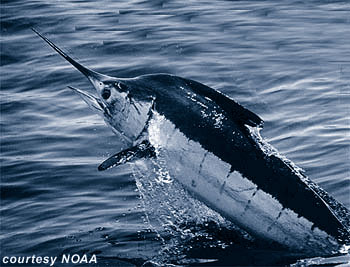
Makaira nigricans
Blue marlin are the largest of the billfish, growing to 14 feet long and weighing up to a ton (the females are often significantly larger than males). They have distinct long bills, forked tail fins, and a first dorsal fin with a high initial crest that slopes sharply down and runs along most of the back. They are fast and powerful swimmers that prefer bluewater (open sea) where they can pursue schooling surface fish that they stun with their long bills.
Order – Perciformes
Family – Istiophoridae
Genus – Makaira
Species – nigricans
Common Names
English language common names include blue marlin, Atlantic blue marlin, billfish, cuban black marlin, marlin, ocean gar, and ocean guard. European common names include abanico (Spanish), aguja (Spanish), castero (Spanish), prieta (Spanish), voladora (Spanish), blauer marlin (German), espadarte-sombra (Portuguese), espadon (French) and makaire bleu (French). In Japan this fish is often referred to as nishikuro and in Africa the common names of the blue marlin include blou marlyn and sulisuli.
Importance to Humans
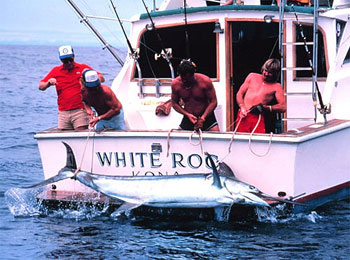
The blue marlin is an important game fish. Blue marlin are greatly coveted by sportsfishers and trophy hunters. The presence of this species in the waters offshore of a number of developing countries provides important economic benefit to such areas. The blue marlin’s flesh is served raw and is a popular sushi fish in Japan, and is popular table fare in some Pacific islands such as Hawaii.
Conservation
This species has been under intense fishing pressure in recent years from longline fishing. The Japanese and Cubans harvest over a thousand tons of blue marlin annually from the Caribbean region alone. Within 200 miles of the U.S. coastline, vessels are required to release all billfish captured, although survival rate is low due to death or damage during capture by these vessels.
> Check the status of the blue marlin at the IUCN website.
The IUCN is a global union of states, governmental agencies, and non-governmental organizations in a partnership that assesses the conservation status of species.
Geographical Distribution
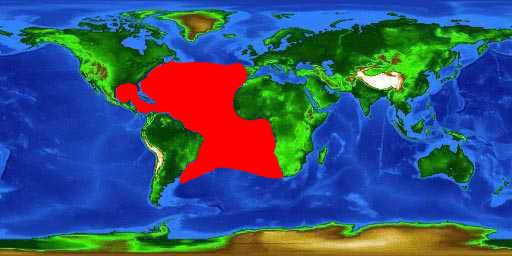
The blue marlin is found primarily in the temperate and tropical regions of the Atlantic Ocean. Based on commercial fishing observations, the blue marlin occurs from about 44° N to 30°S.
Habitat
Occurring offshore in blue oceanic waters, the blue marlin prefers to stay in the warm waters near the surface, above the thermocline. They follow the seasonal water temperature changes, being closely tied to these warm waters. They are found in ocean waters great distances from the continents as well as coastal regions near deep waters, such as near the Mississippi River in the Gulf of Mexico.
Biology
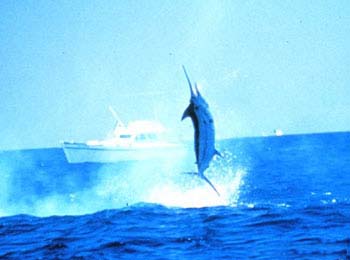
Distinctive Features
The blue marlin is the largest billfish. The upper jaw forms a large bill. The body is cylindrical from anal fin forward. Two dorsal fins are present; the first dorsal fin is high and slopes steeply posteriorly, while the second is small. The caudal peduncle has keels. The lateral line forms a large net-like pattern of hexagons canvasing the sides of the fish. The pelvic fins are slender. The lateral keels on the caudal peduncle assist in making this fish a powerful swimmer of great speed and stamina. Grooves for the pelvic fins improve hydrodynamics.
Coloration
The body is dark blue dorsally, shading to a silvery white ventrally. On the body there are 15 vertical rows of blue spots on the side, on a background of blue to silvery white.
Food Habits
Primarily near-surface pelagic fishes such as mackerels, tunas, and dolphinfishes are preyed upon by the blue marlin. Squids, and the occasional deep sea fish have been noted in the stomachs of blue marlin. Considerable disagreement among researchers exists over whether or not the bill is used during feeding. It is believed by some to be used to stun prey with a swift lateral strike or strikes. The blue marlin is capable of consuming prey of relatively large proportions. Blue marlin are not known to feed at night.
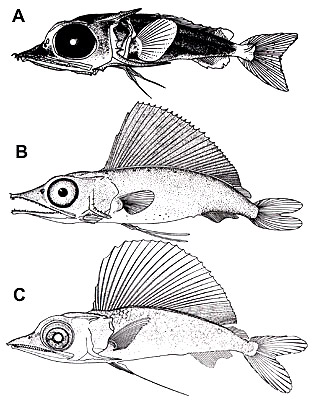
Reproduction
Spawning is known to occur near Cuba between May and November. Egg hatching is dependent upon temperature, but likely occurs well within a week. A single spawning produces millions of eggs each 1 mm in diameter, opaque white or yellow in color. Larvae are blue-black on the sides and dorsal surface, white ventrally. The caudal peduncle and caudal fin are clear. The head has two iridescent blue patches. Some individuals have darker spots along the back. The first dorsal fin in juveniles is very large and concave, gradually reducing in proportion to body size as growth continues.
Predators
Predators of the blue marlin include the white shark (Carcharodon carcharias) and shortfin mako (Isurus oxyrinchus).
Parasites
Although the blue marlin is well-studied, only 28 species of parasites have been reported worldwide from this fish. Parasites include digenea (flukes), didymozoidea (tissue flukes), monogenea (gillworms), cestoda (tapeworms), nematoda (roundworms), acanthocephala (spiny-headed worms), copepods, barnacles, and fish such as remoras (Remora sp.) and the cookie-cutter shark (Isistius brasiliensis) which is known to take bites out of the flesh of marlins.
Taxonomy
The blue marlin, Makaira nigricans, was first described by Lacepede in 1802. The taxonomic status of the blue marlin is a matter of some debate. Certain authors consider the blue marlin a species with a worldwide distribution in tropical and warm- temperate waters, while other authors consider the blue marlin of the Pacific and Indian oceans a distinct species, Makaira mazara, a conclusion based largely on differences in lateral line structure. The genus name Makaira is derived from the Latin machaera, which means “sword.” Other names which have previously been used for the blue marlin include Tetrapturus herschelii Gray 1838, Histiophorus herschelii Gray 1838, Tetrapturus amplus Poey 1860, Tetrapturus herschelii Gray 1838, Makaira bermudae Mowbray 1931, Makaira nigricans ampla Poey 1860, Makaira ampla ampla Poey 1860, Makaira perezi Buen 1950, and Orthocraeros bermudae Mowbray 1931.
Prepared by: Susie Gardieff